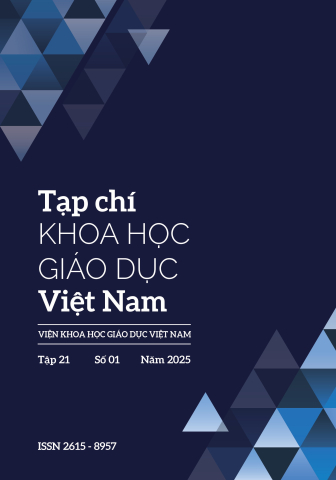[1] Thủ tướng Chính phủ, (10/5/2017), Quyết định số 622/QĐ-TTg ban hành Kế hoạch hành động quốc gia thực hiện Chương trình nghị sự 2030 vì sự phát triển bền vững.
[2] Thủ tướng Chính phủ, (04/6/2019), Quyết định số 681/QĐ-TTg ban hành Lộ trình thực hiện các mục tiêu phát triển bền vững Việt Nam đến năm 2030.
[3] Bộ Giáo dục và Đào tạo, (26/6/2017), Quyết định số 2161/QĐ-BGDĐT ban hành Kế hoạch thực hiện mục tiêu phát triển bền vững lĩnh vực giáo dục và đào tạo đến năm 2025 và định hướng đến năm 2030
[4] Woodhouse, D., (1999), Quality and quality assurance, Quality and Internationalisation in Higher Education, OECD-IMHE, Paris, 29.
[5] Nguyễn Minh Đường, (2004), Cơ sở khoa học và phương pháp xây dựng các tiêu chí đánh giá chất lượng giáo dục trung học chuyên nghiệp, Báo cáo khoa học đề tài CTGD-2004-01
[6] Trần Kiều, (2006), Nghiên cứu xây dựng phương thức và một số bộ công cụ đánh giá chất lượng giáo dục phổ thông, đề tài cấp Bộ CTGD-2004-01, Viện Chiến lược và Chương trình giáo dục.
[7] Jennifer Clarke, (2017), Sustainable pedagogical leadership in early childhood education and care: implementing the 2012 Australian national quality standard, Faculty of Education Queensland University of Technology.
[8] La Paro, K., Thomason, A., Lower, J., KintnerDuffy, V., & Cassidy, D, (2012), Examining the definition and measurement of quality in early childhood education: a review of studies using the ECERS-R from 2003 to 2010, Early Childhood Research & Practice, 14(1).
[9] Da Silva, L., & Wise, S, (2006), Parent perspectives on childcare quality among a culturally diverse sample, Australian Journal of Early Childhood, 31(3), 6-14
[10] Green, N, (2007), Exploring quality in early educational communities, In Vision into practice. Retrieved
[11] Huntsman, L, (2008), Determinants of quality in child care: A review of the research evidence, New South Wales, Australia: Centre for Parenting and Research.
[12] Ryder, D., Davitt, G., Higginson, R. & Smorti, S, (2016), Leaders growing leaders: effective early childhood leaders for sustainable leadership, NZEALS Conference April 2016. Retrieved 18 July 2017
[13] Aziz, S., Mahmood, M., & Rehman, Z, (2018), Implementation of CIPP Model for Quality Evaluation at School Level: A Case Study, Journal of Education and Educational Development, 5(1), p.189-206
[14] Rob Vos, (1996), Educational indicators: What’s to be measured? Working Paper Series I-1, Washington D.C.
[15] Jeanette Colby, Miske Witt el. al., (2000), Defining quality in education, UNICEF.
[16] OECD, (2016), Education at a glance 2016, OECD indicators.
[17] UNESCO Institute for Statistics, (March 2022), Official List of SDG 4 Indicators.
[18] OECD, (2006), Starting Strong II: Early Childhood Education and Care, Paris: OECD Publishing.
[19] Vandell, D., & Wolfe, B, (2000), Child Care Quality: Does it Matter and Does it Need to be Improved? Madison, Wisconsin: Institute for Research on Child Poverty, University of Wisconsin-Madison.
[20] Cassidy, D., Hestenes, L., Hansen, J., Hegde, A., Shim, J., & Hestenes, S, (2005), Revisiting the two faces of child care quality: Structure and process, Early Education and Development, 16(4), 505-520. doi: 10.1207/s15566935eed1604_10.
[21] Hamre, B., & Pianta, R, (2007), Learning opportunities in preschool and early elementary chất lượngassrooms, In R. C. Pianta, M. J. Cox & K. L. Snow (Eds.), School readiness and the transition to kindergarten in the era of accountability (pp. 49-83). Baltimore, MD: Brookes.
[22] Bộ Giáo dục và Đào tạo, (22/8/2018), Thông tư số 19/2018/TT-BGDĐT ban hành Quy định về kiểm định chất lượng giáo dục và công nhận đạt chuẩn quốc gia đối với trường mầm non.
[23] The Commonwealth, (2017), Universal Standards for Quality in Education to enable the delivery of Sustainable Development Goals 2030.


